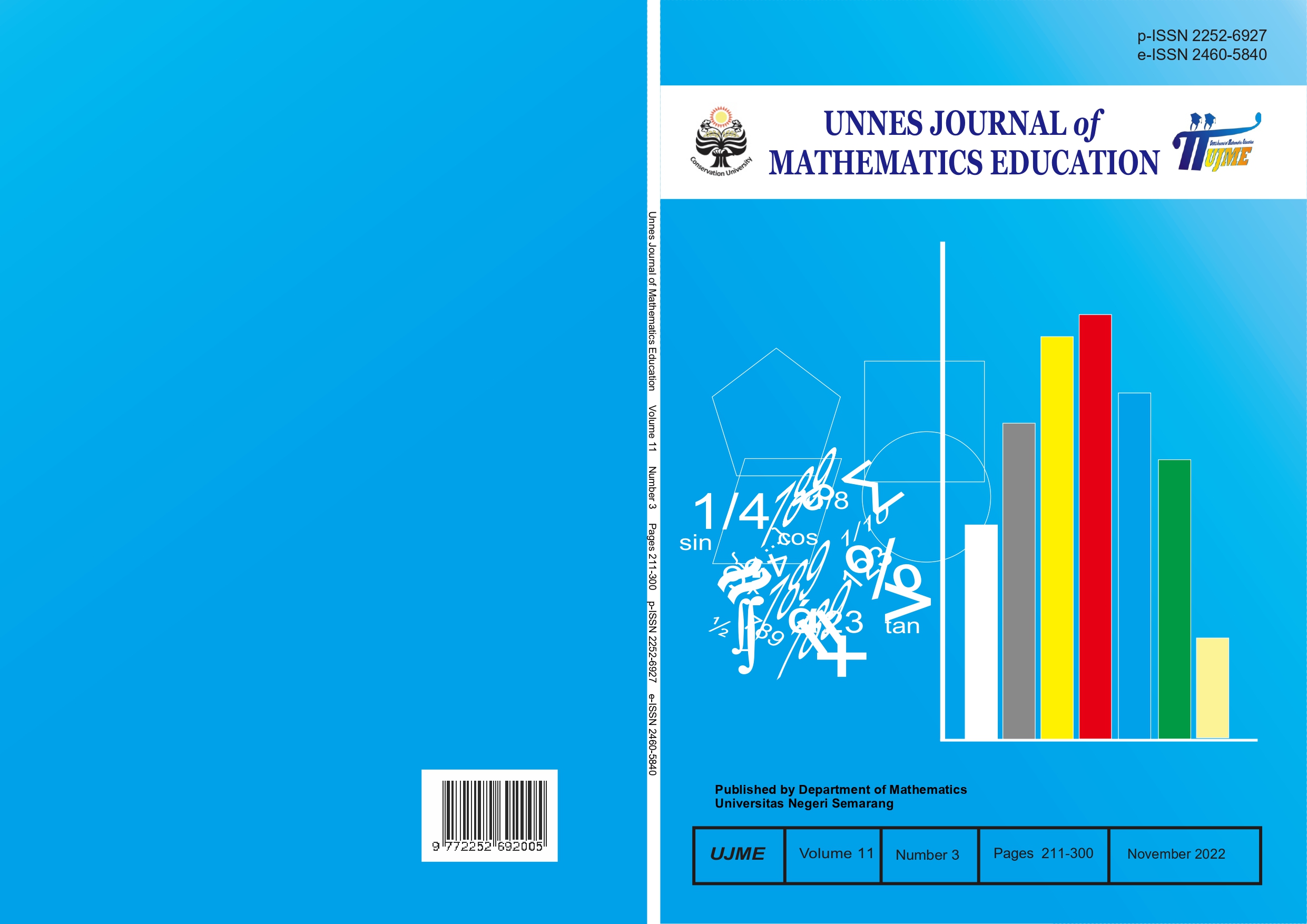Development of Student Worksheets-Based Guided Discovery with a Scientific Approach to Improve Mathematical Connection Ability
##plugins.themes.academic_pro.article.main##
Abstract
The purpose of this study was to develop student worksheets-based on guided discovery with a scientific approach to improve students' mathematical connection ability. The criteria for developing student worksheets are valid, practical, and effective. Type of research is research and development with the ADDIE model (Analysis, Design, Development, Implementation, Evaluation). The research subjects were grade 7A junior high school 2 Pulokulon. Data collection techniques include product assessment, questionnaires, observations, and tests. Data analysis techniques include validity test, practicality test, and effectiveness test. The results showed that: (1) the student worksheets met the expert validity with a score of 4.4 and were very good, (2) the student worksheets met practicality with a score of 3.16 with a very good category, and (3) the student worksheets are effective for improving students' mathematical connection ability with classical mastery learning outcomes by 77% and increasing abilities with N-Gain = 0.54 in the medium category.
##plugins.themes.academic_pro.article.details##
References
Ahmadi, I. K, & Amri, S (2011). Paikem Gembrot (Mengembangkan Pembelajaran Aktif, Inovatif, Kreatif, Efektif, Menyenangkan, Gembira, dan Berbobot). Jakarta: Prestasi Pustaka Publisher.
Cahyani, U.A.E. (2014). Pengembangan Perangkat Pembelajaran Matematika dengan Pendekatan Penemuan Terbimbing (Guided Discovery) Materi Prisma dan Limas Untuk Siswa SMP Kelas VIII Semester II. (Skripsi). Universitas Negeri Yogyakarta, Yogyakarta.
Carin, A. A. (1997). Teaching Science Through Discovery. 8th. Ed. Upper Saddle River, New
Jersey Columbus, Ohio: Pearson Prentice Hall, Inc.
Departemen Pendidikan Nasional. (2008). Direktorat Pendidikan Sekolah Menengah Atas. Panduan Pengembangan Bahan Ajar. Jakarta: Depdiknas.
Hamalik, O. (2009). Perencanaan Pengajaran Berdasarkan Pendekatan Sistem. Jakarta: Bumi Aksara.
Hanafiah, N. & Suhana, C. (2009). Konsep Strategi Pembelajaran. Bandung: Aditama.
Howe, A, C. & Jones, L. (1993). Engging Children in Science. Michigan University: Merill Colage.
Jihad, A. (2008). Pengembangan Kurikulum Matematika (Tinjauan Teoritis dan Historis). Bandung: Multipressindo.
Kapuspendik. (2019). Hasil Ujian Nasional 2019. Retrieved on https://file.pdkjateng.go.id/UNP/MateriRakorUNP2019/PaparanKapuspendik.pdf
Mauzana, N. (2016). Pengembangan Lembar Kerja Siswa (LKS) Berbasis Guided Pendekatan Saintifik pada Mata Pelajaran Matematika Kelas VIII MTs (Doctoral dissertation). UIN Ar-Raniry Banda Aceh, Banda Aceh.
Muharom, T. (2014) Pengaruh Pembelajaran dengan Model Kooperatif Tipe Student Teams Achievement Division (STAD) Terhadap Kemampuan Penalaran dan Komunikasi Matematik Peserta Didik di SMK Negeri Manonjaya Kabupaten Tasikmalaya (The Effect of Learning with the Cooperative Model Type Student Teams Achievement Division (STAD) on the Ability of Mathematical Reasoning and Mathematical Communication in the Manonjaya Vocational School, Tasikmalaya Regency). Jurnal Pendidikan dan Keguruan. 1(1). Hlm. 1-11.
Mulyani, M., & Muhtadi, D. (2019). Peningkatan Kemampuan Koneksi Matematik dan Berpikir Kreatif Siswa Melalui Pembelajaran Guided Discovery Di SMA AL Muttaqin (Increasing mathematical connection capabilities and creative thinking students through guided discovery learning at Al Muttaqin High School). In Prosiding Seminar Nasional & Call for Papers.
Mulyatiningsih, E. (2012). Riset Terapan Bidang Pendidikan dan Teknik. Yogyakarta: UNY Press.
Naibaho, M. E. (2012). Hubungan Kecerdasan Emosional dan Kemampuan Komunikasi Interpersonal Guru dengan Motivasi Belajar Siswa di SMP Negeri 14 Medan (Relationship between the emotional intelligence and interpersonal communication skills of teachers with student learning motivation in Medan 14 Middle School). Jurnal Pendidikan.
NCTM. (2000). Principle and Standards for School Mathematics. Virginia: NCTM.
Nopriyanti, T. D. (2015). Pengembangan Soal untuk Mengukur Kemampuan Koneksi Matematis Peserta Didik. Palembang: Universitas PGRI Palembang,. hal. 1021.
Putra, D.O. (2018). Pengembangan Lembar Kerja Siswa Berbasis Guided Discovery untuk Memfasilitasi Kemampan Koneksi Matematika Siswa Sekolah Menengah Pertama Negeri 1 Kampar Timur. (Doctoral Dissertation). Universitas Islam Negeri Sultan Syarif Kasim Riau, Riau.
Putra, N. (2011). Research and Development Penelitian dan Pengembangan: Suatu Pengantar. Jakarta: Rajagrafindo Persada.
Simamora, R.E., & Siagian, M.V. (2021). Penerapan Model Guided-Discovery Learning (GDL) dengan Pendekatan Saintifik Berbantuan Geogebra Pada Topik Geometri (Application of the Guided-Discovery Learning (GDL) model with a geogebra-assisted scientific approach to the topic of geometry). TIN: Terapan Informatika Nusantara, 1(11),576-581.
Stylianides, A. J. & Stylianides, J. S. 2007. Learning Mathematics with
Understanding: A Critical Consideration of the Learning Principle in the
Principles and Standards for School Mathematics. The Montana
Mathematics Enthusiast 4(1):103–14.
Sugiman. (2008). Koneksi Matematik dalam Pembelajaran Matematika di Sekolah Menengah Pertama. Retrieved on staff.uny.ac.id//sites/default/files/131930135/2008_Koneksi_Mat.pdf.
Susanti, E., Rodiawati, A., Syam, S.S. (2017). Discovery Lerning Untuk Meningkatkan Kemampuan Pemahaman dan Koneksi Matematis (Discovery Learning to improve mathematical understanding and connection capabilities). In Prosiding Seminar Nasional Matematika dan Pembelajaran (pp.1113-1122).
Trianto. (2012). Mendesain Model Pembelajaran Inovatif Progresif: Konsep landasan dan Implementasinya dalam Kurikulum Tingkat Satuan Pendidikan (KTSP). Jakarta: Kencana Prenada Media Group.
Widoyoko, E. P. (2009). Evaluasi Program Pembelajaran: Panduan Praktis bagi Pendidik dan Calon Pendidik. Yogyakarta: Pustaka Belajar.
